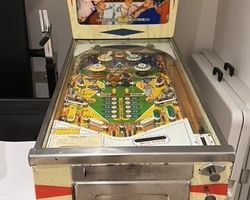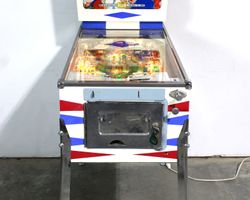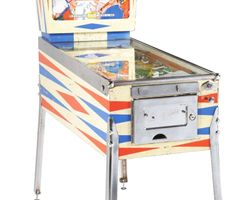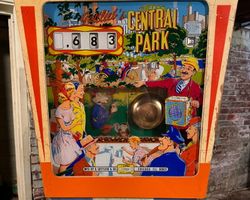Central Park
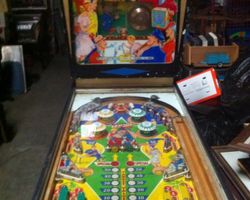
Average Prices: USD $500 to $1,200
Produced: April, 1966
Production Run: 3,100 units
Machine Type: Electro-mechanical
Players: 1
Design by: Ed Krynski
Art by: Art Stenholm, Roy Parker
Gottlieb's "Central Park," released in April 1966, stands as a notable electro-mechanical (EM) pinball machine from a pivotal era in the industry. Produced by D. Gottlieb & Co., a manufacturer recognized for its robust and engaging designs, this machine captured the essence of its namesake through vibrant artwork and a compelling playfield. The creative force behind "Central Park" was Ed Krynski, who conceived the game's core design, mechanics, and even the unique backbox animation. The visual identity of the machine was shaped by the artistry of Art Stenholm and Roy Parker, whose work brought the idyllic, bustling theme of an urban park to life. With 3,100 units produced, "Central Park" found its way into arcades and entertainment venues, offering players a distinctive Gottlieb experience. A lesser-known fact is that Gottlieb also released an add-a-ball version of this design in the same year, known as "Hurdy Gurdy," offering a slightly different gameplay loop for operators and players seeking extended play.
Signature Features and Design
"Central Park" is defined by several standout elements that contribute to its character and gameplay. Foremost among these is the mechanical backbox animation, a hallmark of Gottlieb machines from this period. Nestled within the backglass artwork, an animated monkey, complete with an organ grinder, strikes a brass bell every time 100 points are scored. This kinetic feature provides immediate, satisfying auditory and visual feedback, reinforcing player achievements and adding a layer of charm. The monkey animation, a marvel of mechanical ingenuity, became an iconic identifier for the machine, captivating players with its simple yet effective movement. Beyond the animated backbox, the machine’s cabinet design, often featuring a distinct red, white, and blue color scheme, reflected Gottlieb's prevailing aesthetic preferences of the 1960s, giving it a familiar and inviting presence on location. This attention to cohesive design, from the playfield to the backglass and cabinet, ensured that "Central Park" was not merely a game but a themed experience.
Playfield and Mechanics
The playfield of "Central Park" presents a layout designed to challenge and engage players through precise shots and strategic nudging. At the heart of the lower playfield are two flippers, flanked by two slingshots, typical of the era's design. The central area features a prominent flipper gap, a signature element that contributes significantly to the game's reputation for difficulty. Four pop bumpers are strategically placed in the upper playfield, serving as primary scoring opportunities when the ball reaches this area. The machine incorporates twelve standup targets, divided into two distinct groups of five (targets 1-5 and 6-10), along with two additional targets. Completing targets 1-5 advances the "yellow bonus," while completing targets 6-10 advances the "green bonus." Hitting the illuminated yellow or green target then scores the accumulated bonus, providing a clear objective for players.
The flow of "Central Park" is characterized by rapid ball movement and a demand for controlled play. The generous outlanes, positioned on both the left and right, are notorious for quickly ending a ball's journey, adding to the game's challenge. The smaller flippers, common in 1960s EM machines, necessitate greater accuracy and a refined sense of timing for effective shots. Artwork on the playfield and backglass vividly depicts scenes from Central Park, with intricate details and a lively color palette that captures the theme's essence. The lighting scheme highlights key targets and scoring opportunities, guiding the player's focus and enhancing the overall aesthetic immersion. The sound design, featuring three distinct bells and a knocker for replay scores, provides a classic auditory landscape that complements the mechanical action, reinforcing the satisfaction of successful shots and bonus awards.
Gameplay Dynamics
The gameplay dynamics of "Central Park" revolve around a clear, albeit challenging, progression system built on risk and reward. The primary objective is to advance the yellow and green bonus values by hitting their respective sets of numbered standup targets. Once a bonus value is advanced, hitting its corresponding lit target, typically located front and center, awards the accumulated points. This creates a compelling strategic choice: pursue the high-value, high-risk center targets, or focus on accumulating bonus value first. The maximum displayed point score on "Central Park" is 1,999 points, and replays can be earned up to a maximum of 15 on the replay wheel.
What truly distinguishes "Central Park" is its demanding nature. The small flippers, combined with a significant gap between them and the unforgiving outlanes, make ball control paramount. Without skilled nudging, the game can feel highly dependent on chance, with short ball times being a common experience. However, for players who master the art of nudging, the machine transforms into a "nudger's paradise," where controlled shoves and bumps can save a draining ball or redirect it for a crucial shot. The opening skill shot, aimed at the top rollovers, is also vital for lighting specials and setting up early scoring opportunities. Players often find that the most consistent points are available in the upper playfield, where the four pop bumpers offer rapid scoring. Despite a relatively simple rule set, the depth of "Central Park" emerges from its demanding physical execution, compelling players to refine their technique and strategic decision-making on every ball.
Reception and Legacy
"Central Park" enjoys a positive reputation within the pinball community, particularly among enthusiasts of electro-mechanical machines. Its status as a "classic" Gottlieb title is frequently cited, with many collectors considering it a worthwhile addition to their collections. The machine's primary strength lies in its challenging yet addictive gameplay. Players are consistently drawn back for "just one more game," compelled by the desire to conquer its formidable difficulty. The need for precise nudging is a widely acknowledged characteristic, turning the game into a test of skill and finesse rather than pure luck. This emphasis on player interaction, alongside the clear, satisfying goal of lighting specials and earning free games, contributes to its enduring appeal.
The animated monkey in the backbox is almost universally loved, providing a distinctive and charming feature that sets "Central Park" apart. However, this mechanical animation is also a common point of weakness, susceptible to wear and tear over decades of operation. While some players find the frequent bell ringing for every 100 points occasionally repetitive, it remains an integral part of the machine's sonic identity. The artwork, particularly the backglass, is often praised for its beauty and ability to capture the theme effectively for its era. Despite the difficulty stemming from the flipper gap, small flippers, and swift outlanes, "Central Park" is celebrated for its solid Gottlieb build quality. Its legacy is cemented as a prime example of challenging 1960s EM design, showcasing how a relatively simple rule set, combined with demanding physical play and unique mechanical features, can create a deeply engaging and memorable pinball experience that continues to captivate players decades after its release.
Sponsored Links
 Ebay Listings
Ebay Listings
 Auction Results
Auction Results
| Cost | Location | Date |
|---|---|---|
| GBP £1,537 |  Southall, United Kingdom Southall, United Kingdom |
22 November, 2025 |
| USD $750 |  Massachusetts, United States Massachusetts, United States |
17 April, 2025 |
| USD $550 |  California, United States California, United States |
16 January, 2025 |
| USD $1,300 |  North Carolina, United States North Carolina, United States |
11 October, 2024 |
| USD $750 |  Ohio, United States Ohio, United States |
12 September, 2024 |
| GBP £600 |  United Kingdom United Kingdom |
24 June, 2024 |
| USD $1,800 |  United States United States |
20 May, 2024 |
| USD $800 |  Maryland, United States Maryland, United States |
18 January, 2024 |
| GBP £1,100 |  Newcastle Upon Tyne, United Kingdom Newcastle Upon Tyne, United Kingdom |
19 November, 2023 |
| USD $2,400 |  New York, United States New York, United States |
25 September, 2023 |


Private Policy · Search Website · Contact Us
As an eBay Partner, we may earn a commission from qualifying purchases made through links on this site, at no additional cost to you.
All trademarks and copyrighted materials remain property of their respective owners. All other content copyright 2007 - 2025 Pinpedia.

